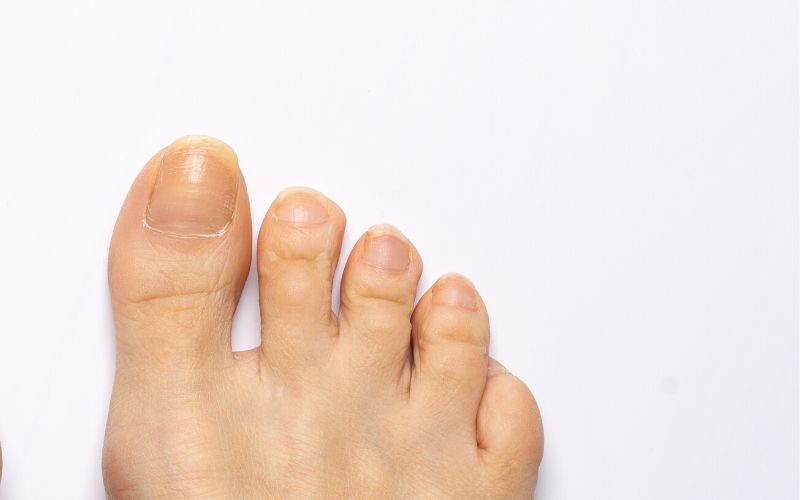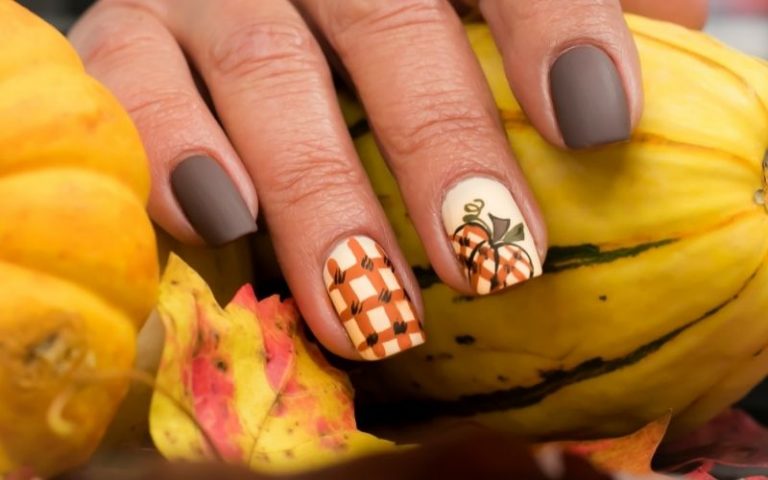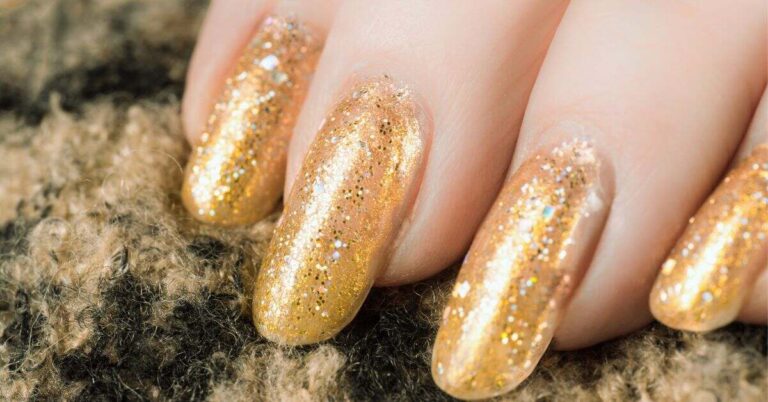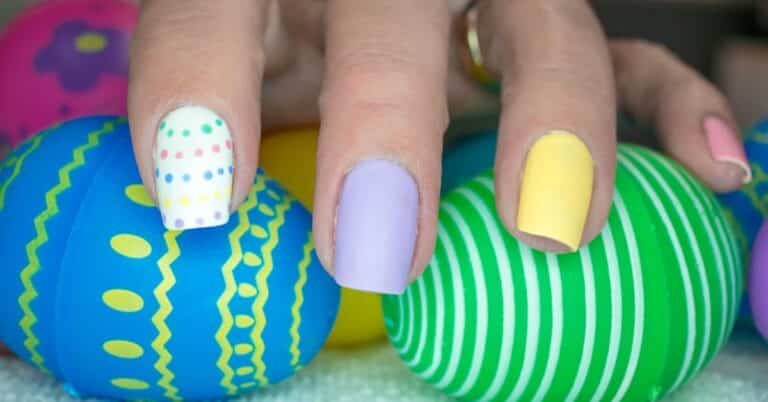Health Effects And Treatment Options For Yellow Toenails

Yellow toenail is one of the nail conditions caused by factors like fungal infection, age factor, lack of cleanliness, and medical conditions. Mostly, you can treat it with simple home remedies.
People usually believe that nail color and appearance have something to do with their health condition. They panic when they notice changes in their nail color or texture. If you ever come across this situation, read this to know all the things related to yellow toenails.
Table Of Contents
- Why Do Your Toenails Turn Yellow?
- Symptoms of Yellow Toenails: Identifying Common Signs
- Diagnosis and Treatment Options
- Home Remedies
- Self-Care Tips
- Prevention and Maintenance
Why Do Your Toenails Turn Yellow?
Your toenails may turn yellow for various reasons. Some trigger points may be natural and predictable; others may be serious health conditions. Understanding the causes is helpful and important to treat them with the right methods and diagnose the health issues at the initial stage.
As we age, we can expect more changes in our internal and external organs. Skin dryness, fine lines, and wrinkles are some skin changes. Like that, our nails also undergo changes like nail breakage, splits, and color changes.
When you walk barefoot, the fungi and other germs in the ground, dirty mats, and other surfaces enter your nails through breakages and wounds. It may lead to a fungal infection called onychomycosis and eventually yellow toenails.
Sometimes, your nail polishes can also be the reason for this yellow color. We all love to try different colors and different nail shades. Some dark colors like red, maroon, or orange may leave a yellowish coating on our nails. It will become more visible when the nail polish layer peels off or once we remove it with remover liquid.
Yellow nails can be the tell-tale sign that reveals the secret that you are a smoker. How are smoking habits and nail color connected? The chemicals in smoke deposit over your nails and turn them yellow. These chemicals also block blood and oxygen supply to your nails. This can also be a reason for this color change.
If you have the habit of visiting a spa for a manicure and pedicure, this section is for you. When your nail technician uses the same tools for different customers without proper cleaning or sterilization, those tools spread the germs from one person to another, causing infections.
Sometimes, your body gives you hints about some serious health conditions through these yellow toenails. It can be anything from the following list.
- Jaundice, a medical condition, turns your nail, skin, eye, and mouth yellow.
- Yellow, thickened, curved nails may indicate Yellow Nail Symptoms, a sign of respiratory issues.
- Yellow at the nail tip can be a symptom of nail psoriasis.
- Yellow nails, bleeding, color changes in the nail bed, and inflammation may indicate sarcoidosis.
- Diseases like diabetes may also turn your nails yellow. Diabetes patients may get frequent fungal infections. This infection also turns their nail yellow.
- Thyroid variations may create imperfections in the nail’s shape, color, and structure.
- Paronychia, a nail infection, may create some abnormalities in your nail shape and color.
Symptoms of Yellow Toenails: Identifying Common Signs
Yellow toenails can be an alarming sight and are often associated with various underlying conditions or infections. While the discoloration itself is not always a cause for concern, it’s essential to pay attention to accompanying symptoms that may indicate an underlying issue.
1. Thickening of the Toenails
One of the primary symptoms of yellow toenails is the thickening of the nail plate. The affected nails may become noticeably thicker than usual, making it challenging to trim or maintain them. This thickening can be attributed to several factors, including fungal infections, nail trauma, or underlying medical conditions.
2. Brittleness and Crumbling
Yellow toenails may exhibit increased brittleness and a tendency to crumble or break easily. The nails may become fragile, losing their natural strength and resilience. This symptom can be caused by fungal infections, nutrient deficiencies, excessive moisture, or frequent exposure to chemicals or irritants.
3. Discoloration and Yellowing
Yellowing or discoloration is the most apparent symptom associated with yellow toenails. The nails may turn a shade of yellow, brown, or even green. While fungal infections are a common cause of discoloration, other factors like smoking, poor hygiene, and certain medical conditions could also lead to a yellow appearance.
4. Foul Odor
A foul odor emanating from the affected toenails is another sign to watch out for. This unpleasant smell can be particularly strong when the nails are kept covered or inside footwear. Fungal infections, bacteria, or the breakdown of keratin protein within the nails can contribute to this odor.
5. Pain or Discomfort
In some cases, yellow toenails may be accompanied by pain or discomfort. The affected nails or the surrounding skin may feel tender, sore, or irritated. This symptom can indicate an underlying infection or inflammation, requiring prompt medical attention.
6. Separation from the Nail Bed
As the condition progresses, yellow toenails may begin to separate from the nail bed. The nails may lift or detach partially or entirely, leading to an uncomfortable gap between the nail and the toe. This separation can allow debris, moisture, or infections to accumulate, exacerbating the symptoms.
7. Nail Deformities
Yellow toenails may exhibit various deformities, such as irregular shapes or unusual textures. The nails may develop ridges, pits, or indentations, compromising their smooth appearance. These deformities can arise due to a range of factors, including trauma, infections, or underlying medical conditions.
8. Itching and Irritation
Persistent itching and irritation around the toenails are common symptoms associated with yellow toenails. The affected area may feel intensely itchy, leading to scratching and potential skin damage. Itchiness can be a result of fungal infections, allergies, or skin conditions like psoriasis.
9. Nail Lifting or Detachment
Yellow toenails can progressively lift or detach from the nail bed, causing significant concern. This separation can create space for moisture, bacteria, and fungi to thrive, leading to further complications. Prompt treatment is necessary to prevent the spread of the condition and promote nail reattachment.
10. Slow Growth or Lack of Growth
Affected toenails may exhibit slow growth or a complete lack of growth. The nails may appear stunted or fail to grow beyond a certain length. This symptom can indicate an underlying issue that hinders proper nail development and growth.
11. Swelling and Redness
Inflammation, swelling, and redness around the toenails can occur alongside yellow discoloration. These symptoms often suggest an underlying infection or an inflammatory condition. Prompt medical attention is necessary to prevent complications and alleviate discomfort.
12. Bleeding or Pus
In severe cases, yellow toenails may bleed or ooze pus. This symptom is indicative of an advanced infection or a more serious underlying condition. It requires immediate medical intervention to prevent further complications and facilitate proper healing.
13. Fungal Infection
One prevalent cause of yellow toenails is a fungal infection, such as onychomycosis. Symptoms of fungal infection can include yellow discoloration, thickening, brittleness, itching, and a foul odor. Fungi flourish in warm, moist environments, making the toes an ideal breeding ground.
14. Skin Rash or Irritation
Yellow toenails may be accompanied by a skin rash or irritation around the affected area. The skin may appear red, inflamed, or develop a rash-like texture. This result can be a resultant of an allergic reaction, dermatitis, or an underlying infection.
15. Nail Thickening or Crumbling in Other Areas
While yellow toenails are the most common manifestation, nail thickening or crumbling can also occur in other areas, such as fingernails or toenails of different colors. Pay attention to any changes in nail texture or appearance, as they can provide valuable insights into potential underlying causes.
Yellow toenails can be an indication of various underlying conditions or infections. Identifying the accompanying symptoms is crucial in understanding the potential causes and seeking appropriate treatment. If you perceive any of these symptoms persisting or worsening, it is advisable to consult a healthcare professional for a proper diagnosis and guidance.
Diagnosis and Treatment Options
1. Seeking Medical Advice
If you catch any of the above symptoms, it is advisable to seek medical advice. A healthcare professional can examine your toenails, evaluate the severity of the condition, and render an accurate diagnosis. They might also recommend additional tests or provide a referral to a medical specialist – podiatrist or dermatologist – for further evaluation.
2. Over-The-Counter Treatments
Over-the-counter (OTC) treatments can be the first line of defense against yellow toenails, particularly in mild cases. Antifungal creams, ointments, and sprays containing ingredients like clotrimazole or terbinafine can help combat fungal infections. It’s important to follow the instructions provided and continue the treatment as recommended to achieve effective results.
3. Prescription Medications
In more severe cases or when OTC treatments prove ineffective, a healthcare professional may prescribe oral antifungal medications. These prescription medications, such as itraconazole or fluconazole, can help address stubborn or recurring fungal infections. It’s crucial to take these medications as prescribed and follow up with the healthcare provider for monitoring and potential side effects.
4. Laser Treatment
Laser treatment has gained popularity as an alternative option for treating yellow toenails caused by fungal infections. This non-invasive procedure uses focused laser beams to target and destroy the fungi present in the nails.
Multiple sessions may be desired to achieve optimal results, and it’s important to consult a dermatologist or podiatrist specializing in laser treatment to determine its suitability and effectiveness for your specific case.
5. Surgical Intervention
In rare cases where yellow toenails are severe, painful, or accompanied by complications like abscesses or ingrown nails, surgical intervention may be necessary. Procedures such as nail avulsion or partial/total nail removal may be performed to eliminate the infected or damaged nail and promote healthy regrowth. These procedures are typically carried out by a podiatrist or dermatologist and may require a period of recovery and proper post-operative care.
Home Remedies
Alongside medical treatments, there are several home remedies that can help manage yellow toenails caused by various factors. While these remedies may not be a substitute for professional medical advice, they can complement the treatment process and promote overall nail health. Here are some home remedies worth considering:
1. Vinegar Soaks
Vinegar, particularly apple cider vinegar, has antifungal properties that can help combat yellow toenails. Dilute equal parts of vinegar and warm water in a basin or foot bath. Soak your feet in this solution for approximately 15-20 minutes daily. Afterward, thoroughly dry your feet to prevent moisture buildup.
2. Tea Tree Oil
Blend a portion of tea tree oil with either olive or coconut oil, and administer the resulting mixture directly onto the affected toenails using a cotton ball. Tea tree oil harbors inherent antifungal properties that aid in combatting fungal infections and enhancing the aesthetic appeal of discolored nails.
3. Baking Soda Paste
Create a paste by blending baking soda and water, and apply it to the affected toenails. Allow the paste to rest for a brief duration before thoroughly rinsing it away. Baking soda can help neutralize the pH level of the nails and create an environment less favorable for fungal growth.
4. Hydrogen Peroxide
Hydrogen peroxide can help kill fungi and bacteria on the nails. Combine an equal ratio of hydrogen peroxide and water in a basin or tub. Immerse your feet in this solution for approximately 15 minutes, then rinse and dry thoroughly. Repeat this technique a few times a week.
5. Garlic
Crush several garlic cloves and combine them with olive oil to form a rich paste. Apply the paste onto the afflicted nails and cover them with a clean bandage. Leave it on for several hours or throughout the course of the night before rinsing it off. Repeat this technique on a daily basis until you observe signs of improvement.
6. Essential Oils
Some essential oils, such as lavender oil, oregano oil, or thyme oil, have antifungal properties. Dilute several drops of the essential oil of your choice in carrier oil – coconut oil or olive oil. Apply the mixture to the affected nails and keep it on for several hours or throughout the night. Repeat this process daily.
Self-Care Tips
Alongside medical treatments, there are various self-care practices that can complement the treatment process and promote nail health:
- Maintain good foot hygiene by regularly washing and drying your feet and paying close attention to the toenails.
- Trim your toenails straight across and refrain from cutting them too short to prevent trauma or damage.
- Wear breathable shoes and moisture-wicking socks to keep your feet dry to minimize the risk of fungal infections.
- Avoid sharing personal items like nail clippers, files, or footwear to reduce the chances of spreading or acquiring infections.
- Apply over-the-counter antifungal powders or sprays inside your shoes to create an inhospitable environment for fungi.
- Opt for breathable footwear, such as open-toed shoes or sandals, whenever possible to allow air circulation and minimize moisture buildup.
- Avoiding nail polish or artificial nails that can trap moisture and exacerbate fungal infections.
- Wearing protective footwear in public areas like pools, locker rooms, and showers.
- Adopting a nutritious diet that is rich in essential nutrients and vitamins to support nail health, such as biotin, zinc, and iron.
- Consider using natural remedies like tea tree oil, vinegar soaks, or essential oils with antifungal properties as adjunct treatments. However, it’s significant to consult a healthcare professional before using these remedies to ensure their safety and efficacy.
Remember, self-care practices and home remedies may help manage mild cases of yellow toenails but may not be sufficient for more severe or persistent conditions. Seeking professional medical advice is crucial for an accurate diagnosis and appropriate treatment plan.
Prevention and Maintenance
To prevent yellow toenails and maintain their health, there are several preventive measures individuals can take.
1. Proper Foot Hygiene
Maintaining proper foot hygiene is essential in preventing and managing yellow toenails. Regularly wash your feet with mild soap and warm water, ensuring to dry them thoroughly, especially between the toes. Trim your nails straight across, avoiding rounded edges, and use clean and sanitized nail tools.
2. Avoiding Damp and Moist Environments
Fungi thrive in damp and moist environments. To prevent fungal infections, avoid walking barefoot in public areas such as swimming pools, communal showers, and locker rooms. Use shower shoes or flip-flops to minimize direct contact with potentially contaminated surfaces.
3. Wearing Breathable Shoes and Socks
Choose shoes that allow proper air circulation to your feet. Opt for breathable materials such as leather or mesh, and avoid tight-fitting shoes that can restrict airflow. Additionally, wear moisture-wicking socks that help keep your feet dry and minimize the risk of fungal growth.
4. Treating Underlying Medical Conditions
If yellow toenails are a result of an underlying medical condition like psoriasis, it is crucial to manage that condition appropriately. Consult a medical professional or a dermatologist for a comprehensive treatment plan.
5. Professional Nail Treatments
In certain situations, seeking professional nail treatments from a podiatrist or nail technician may be necessary. These treatments may include nail debridement, where the thickened or damaged portions of the nails are carefully removed, allowing healthy nail growth.
The Key Takeaway
Yellow toenails can be indicative of an underlying issue that requires attention. By recognizing the common symptoms associated with yellow toenails, individuals can take proactive steps to address the causes and maintain healthy nails.
Seeking medical advice, following appropriate treatment options, and adopting preventive measures are crucial in managing yellow toenails effectively.
Remember, healthy nails contribute to overall well-being, and taking care of them should be an essential part of one’s self-care routine.
FAQs
Q: Which oil is best for treating yellow toenails from fungal infection?
A: Oregano oil, almond oil, grapeseed oil, and olive oil are some choices with antifungal properties to treat yellow toenails from fungal infection.
Q: How does your podiatrist analyze the real cause of yellow toenails?
A: Your podiatrist will cut a small piece of your nail and send it to a laboratory for a thorough examination. There, they check the microscopic view of this nail to find the fungus growth or other conditions.
Q: How can you say that you have healthy nails?
A: If your nail is pinkish in color without any flaws, pain, breakages, and color changes, you can say that your nails are healthy.
Q: Can poor hygiene cause yellow toenails?
A: Poor hygiene alone is unlikely to cause yellow toenails. However, it can contribute to the development or worsening of fungal infections, which are a common cause of yellow discoloration in nails.
Q: How long does it take to treat yellow toenails?
A: The duration may vary depending on the underlying cause and the chosen treatment method. Mild cases may resolve with home remedies within a few weeks, while severe or chronic conditions may require several months of treatment and management.
References
- Why Are My Toenails Yellow?: https://www.healthline.com/health/why-are-my-toenails-yellow
- Remedies For Thick Yellow Toenails: https://www.webmd.com/skin-problems-and-treatments/remedies-thick-yellow-toenails
- What Do Yellow Toenails Mean?: https://www.medicalnewstoday.com/articles/322087
- What Does It Mean When Your Toenails Are Yellow?: https://www.medicinenet.com/what_does_it_mean_when_your_toenails_are_yellow/article.htm





